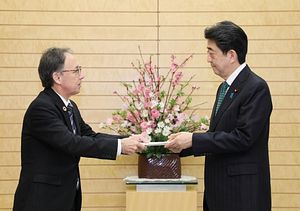The governor of Okinawa has called for three-way talks with the Japanese central government and the United States in a bid to resolve the standoff over a contentious military base project.
The request for dialogue follows a referendum in Okinawa, Japan’s southernmost prefecture, in which local voters overwhelmingly rejected work associated with the relocation of the U.S. Marine Corps Air Station Futenma to the coastal area of Henoko.
About 72 percent of voters opposed the land reclamation work in the referendum on February 24, compared with just 19 percent in favor and a little under 9 percent opting for “neither.” This result was based on turnout of about 52 percent of the 1.2 million eligible voters.
Okinawa Governor Denny Tamaki, who took office in October, described the result as the first clear expression of the people’s will. “In our country, which is a democracy, people’s will – which was directly demonstrated by the local referendum – has more weight than anything else and must be respected therefore,” he said during a press conference at the Foreign Correspondents’ Club of Japan on March 1.
Okinawa, a chain of islands that faces the East China Sea, is seen as a strategically important location within the region. However, residents have long criticized what they see as an excessive burden of hosting American military bases, with complaints about noise, crime, and aircraft accidents.
U.S. Forces Japan told NBC News that “after several recent land returns, less than 64 percent of U.S. exclusive-use areas are on Okinawa, while about 36 percent are on mainland [Japan].”
The Marine Corps Air Station Futenma, which is currently situated within a crowded residential area on Okinawa’s main island, is set to relocate to Henoko under a long-standing plan agreed by the U.S. and Japanese governments. Some locals have raised environmental concerns about the necessary land reclamation work for the new base in Oura Bay, while other campaigners want the base moved outside of Okinawa altogether.
Tamaki traveled to Tokyo on March 1 to meet with Japanese Prime Minister Shinzo Abe and visit a senior official at the American embassy to discuss the referendum results. He called for respectful dialogue to work through these issues.
One idea he has floated is to involve the Okinawan prefectural government in a relaunched Special Action Committee on Okinawa (SACO), a process originally established by the U.S. and Japanese governments in 1995 to come up with plans to realign American bases and reduce the overall burden on the region. That was launched following local outrage over a rape case involving three U.S. servicemen.
Tamaki said more than two decades had elapsed since the SACO agreement that was the origin of the Futenma relocation plan. He argued it was now time for Tokyo and Washington to set up a “SACO plus Okinawa” dialogue “to verify the progress regarding the SACO agreement as well as to study the return of the base.”
In his meeting with Abe, Tamaki also urged the central Japanese government “to abandon Henoko construction and furthermore to use dialogue, not legal means, to find solutions and to respect the results of the local referendum as well.”
Asked to describe Abe’s response to his proposals, Tamaki said the prime minister’s position had not shifted. Abe indicated that the government planned to proceed with the Henoko reclamation work in order to remove the dangers of the existing Futenma base.
In a media conference on February 25, Abe also insisted the plan “cannot be postponed any longer.” He added, however, that he “sincerely accepted” the referendum result and was committed to continued dialogue with the Okinawan people.
Japanese Defense Minister Takeshi Iwaya told reporters the following day that Tokyo would continue to explain its stance “carefully and persistently to the people of Okinawa” and hoped to be able to “gain their understanding.”
The referendum is nonbinding on the central government. However, under the prefectural ordinance setting up the referendum, the outcome had to be respected by Okinawa’s governor if any proposition was approved by at least 25 percent of eligible voters. Because that benchmark was achieved, Tamaki was also obliged to notify Abe and U.S. President Donald Trump of the result.
The United States is showing no signs of shifting its position, either. Abe and Trump previously agreed that the relocation plan was “the only solution that avoids the continued use of Marine Corps Air Station Futenma.”
In the wake of the referendum, the U.S. ambassador to Japan, William Hagerty, said he hoped to maintain a good relationship with the people of Okinawa “but at the same time I want to emphasize that the only option on the table today is the facility in Henoko to relieve the pressure and the need to get out of the more concentrated, more densely populated facility there at Futenma.”
Hagerty has previously played down the prospect of formal three-way talks. Last November, he said U.S. representatives were in frequent contact with Okinawan leaders but noted the continuing role of bilateral discussions at a country-to-country level. Hagerty said the U.S. position was “driven by our overarching needs to be the strongest force here and to protect the people of Japan and the nations in this region.”
Despite the current emphasis on dialogue, it is possible the dispute will trigger fresh legal and administrative battles between Okinawa and the central government. It will be a delicate issue for Abe and his Liberal Democratic Party to manage ahead of a series of local elections in coming months and a national upper house election in the summer.
Jinshiro Motoyama, an Okinawan activist who had helped campaign for the referendum, joined Tamaki for the post-poll press conference in Tokyo. “The central government should not trample on the Okinawan people’s will,” Motoyama said. “We hope democracy is still alive in this country.”
































